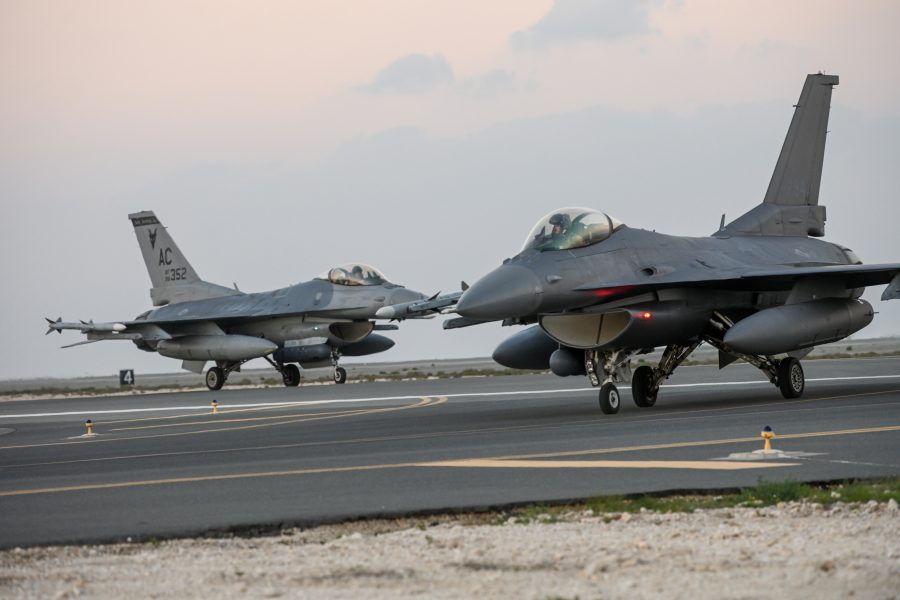U.S. Air Force F-16 fighters are in the midst of a weeklong training exercise with the Royal Bahraini Air Force, Air Forces Central announced.
The exercise, named Ballast Cannon, started Jan. 6 and will last until Jan. 12. In addition to the F-16s, KC-135 tankers are participating. Airmen are incorporating Agile Combat Employment (ACE) objectives into the exercise, as well as practicing aerial refueling, coalition command and control, and tactical integration between the USAF and the RBAF.
“By constantly integrating with our partners at the tactical edge, while still testing our expeditionary capabilities, we are building readiness and developing operational approaches that complicate the adversary’s problem as well as maintains our strategic advantage.” Brig. Gen. Quaid Quadri, 378th Air Expeditionary Wing Commander, said in a statement.
Images released by AFCENT show the F-16s participating in the aircraft to be from the New Jersey Air National Guard—the 119th Expeditionary Fighter Squadron arrived in the Middle East in late October to bolster the Air Force’s fighter footprint in the region amid increased attacks by militia groups aligned with Iran and concerns about possible region-wide escalation of the Israel-Hamas war.
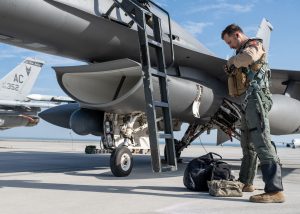
U.S. Air Force Capt. Eliot Shapleigh, an F-16 Fighting Falcon pilot, prepares to board an F-16 during Exercise Ballast Cannon 24.3 at an undisclosed location in the U.S. Central Command area of responsibility, Jan. 7, 2024. Ballast Cannon occurs nearly quarterly with the Royal Bahraini Air Force to support the U.S. Air Force’s rapid expeditionary capabilities by integrating Agile Combat Employment objectives for F-16 Fighting Falcon, KC-135 Stratotanker, and operational support personnel. The exercise allowed Total Force Airmen to generate unique solutions in austere environments. (U.S. Air Force photo by Senior Airman Sarah Williams) 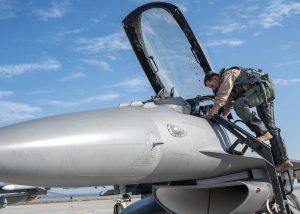
U.S. Air Force Capt. Eliot Shapleigh, an F-16 Fighting Falcon pilot, boards an F-16 during Exercise Ballast Cannon 24.3 at an undisclosed location in the U.S. Central Command area of responsibility, Jan. 7, 2024. Ballast Cannon occurs nearly quarterly with the Royal Bahraini Air Force to support the U.S. Air Force’s rapid expeditionary capabilities by integrating Agile Combat Employment objectives for F-16 Fighting Falcon, KC-135 Stratotanker, and operational support personnel. The long-standing relationships the U.S. Air Force has developed within the CENTCOM AOR enables regular and routine training, which advances the coalition’s ability to become a seamless operational force across every warfighting domain. (U.S. Air Force photo by Senior Airman Sarah Williams)
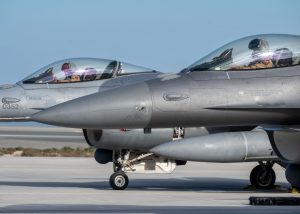
U.S. Air Force pilots conduct preflight checks in F-16 Fighting Falcons during Exercise Ballast Cannon 24.3 at an undisclosed location in the U.S. Central Command area of responsibility, Jan. 7, 2024. Ballast Cannon occurs nearly quarterly with the Royal Bahraini Air Force to support the U.S. Air Force’s rapid expeditionary capabilities by integrating Agile Combat Employment objectives for F-16 Fighting Falcon, KC-135 Stratotanker, and operational support personnel. (U.S. Air Force photo by Senior Airman Sarah Williams)
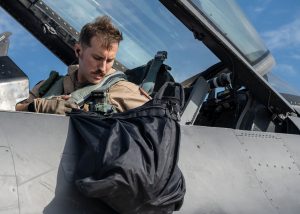
U.S. Air Force Capt. Eliot Shapleigh, an F-16 Fighting Falcon pilot, conducts a preflight check during Exercise Ballast Cannon 24.3 at an undisclosed location in the U.S. Central Command area of responsibility, Jan. 7, 2024. Ballast Cannon occurs nearly quarterly with the Royal Bahraini Air Force to support the U.S. Air Force’s rapid expeditionary capabilities by integrating Agile Combat Employment objectives for F-16 Fighting Falcon, KC-135 Stratotanker, and operational support personnel. American Airman support dynamic operations while seamlessly integrating with coalition forces. (U.S. Air Force photo by Senior Airman Sarah Williams)
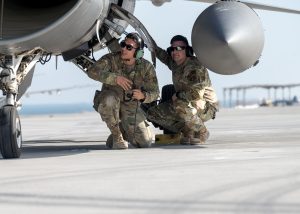
U.S. Air Force Senior Airman Micheal Ortolani, an F-16 Fighting Falcon crew chief, and Tech. Sgt. Jonathan Bollock, a logistics readiness squadron Airman, perform preflight checks during Exercise Ballast Cannon 24.3 at an undisclosed location in the U.S. Central Command area of responsibility, Jan. 7, 2024. Ballast Cannon occurs nearly quarterly with the Royal Bahraini Air Force to support the U.S. Air Force’s rapid expeditionary capabilities by integrating Agile Combat Employment objectives for F-16 Fighting Falcon, KC-135 Stratotanker, and operational support personnel. (U.S. Air Force photo by Senior Airman Sarah Williams)
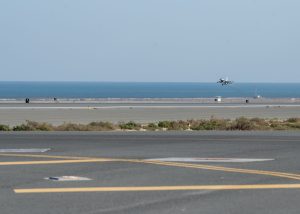
A U.S. Air Force F-16 Fighting Falcon takes off during Exercise Ballast Cannon 24.3 at an undisclosed location in the U.S. Central Command area of responsibility, Jan. 7, 2024. Ballast Cannon occurs nearly quarterly with the Royal Bahraini Air Force to support the U.S. Air Force’s rapid expeditionary capabilities by integrating Agile Combat Employment objectives for F-16 Fighting Falcon, KC-135 Stratotanker, and operational support personnel. The exercise allowed Total Force Airmen to generate unique solutions in austere environments. (U.S. Air Force photo by Senior Airman Sarah Williams)
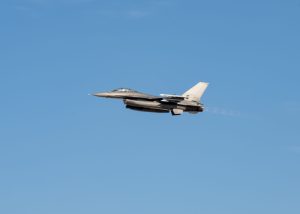
A U.S. Air Force F-16 Fighting Falcon takes off during Exercise Ballast Cannon 24.3 at an undisclosed location in the U.S. Central Command area of responsibility, Jan. 7, 2024. Ballast Cannon occurs nearly quarterly with the Royal Bahraini Air Force to support the U.S. Air Force’s rapid expeditionary capabilities by integrating Agile Combat Employment objectives for F-16 Fighting Falcon, KC-135 Stratotanker, and operational support personnel. Agile Combat Employment shifts generation of airpower from large centralized bases, to networks of smaller, dispersed locations, or cluster bases to increase survivability and complicate adversary planning. (U.S. Air Force photo by Senior Airman Sarah Williams)
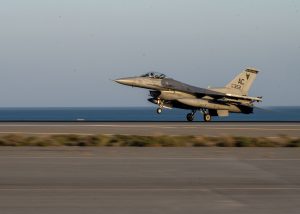
A U.S. Air Force F-16 Fighting Falcon lands at an undisclosed location in the U.S. Central Command area of responsibility during Exercise Ballast Cannon 24.3, Jan. 7, 2024. Ballast Cannon occurs nearly quarterly with the Royal Bahraini Air Force to support the U.S. Air Force’s rapid expeditionary capabilities by integrating Agile Combat Employment objectives for F-16 Fighting Falcon, KC-135 Stratotanker, and operational support personnel. Agile Combat Employment shifts generation of airpower from large centralized bases, to networks of smaller, dispersed locations, or cluster bases to increase survivability and complicate adversary planning. (U.S. Air Force photo by Senior Airman Sarah Williams)
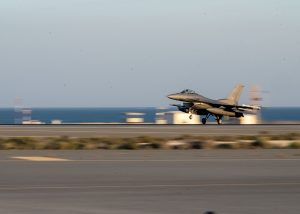
A U.S. Air Force F-16 Fighting Falcon lands at an undisclosed location in the U.S. Central Command area of responsibility during Exercise Ballast Cannon 24.3, Jan. 7, 2024. Ballast Cannon occurs nearly quarterly with the Royal Bahraini Air Force to support the U.S. Air Force’s rapid expeditionary capabilities by integrating Agile Combat Employment objectives for F-16 Fighting Falcon, KC-135 Stratotanker, and operational support personnel. Agile Combat Employment shifts generation of airpower from large centralized bases, to networks of smaller, dispersed locations, or cluster bases to increase survivability and complicate adversary planning. (U.S. Air Force photo by Senior Airman Sarah Williams)
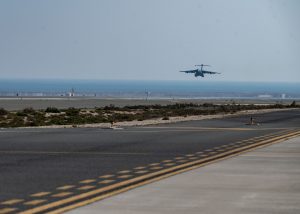
A C-17 Globemaster III lands at an undisclosed location in the U.S. Central Command area of responsibility, Jan. 5, 2024. The C-17 was a part of an exercise that occurs nearly quarterly with the Royal Bahraini Air Force to support the U.S. Air Force’s rapid expeditionary capabilities by integrating Agile Combat Employment objectives. (U.S. Air Force photo by Senior Airman Sarah Williams)
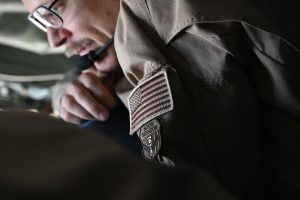
U.S. Air Force Senior Master Sgt. Myron Somero, boom operator evaluator, communicates with Tech. Sgt. Steven Hannah during an aerial refueling for Ballast Cannon 24.3, Jan. 7, 2024. As a routine exercise occurring nearly quarterly with the Royal Bahraini Air Force, this iteration supports the U.S. Air ForceÕs rapid expeditionary capabilities by integrating Agile Combat Employment objectives for F-16 Fighting Falcon, KC-135 Stratotanker, and operational support personnel. (U.S. Air Force photo by Staff Sgt. Jasmonet Holmes)

A U.S. Air Force F-16 Fighting Falcon prepares for an aerial refueling over an undisclosed location within the U.S. Central Command area of responsibility during the quarterly Ballast Cannon, Jan. 7, 2024. As a routine exercise occurring nearly quarterly with the Royal Bahraini Air Force, this iteration supports the U.S. Air Force’s rapid expeditionary capabilities by integrating Agile Combat Employment objectives for F-16 Fighting Falcon, KC-135 Stratotanker, and operational support personnel. (U.S. Air Force photo by Staff Sgt. Jasmonet Holmes)
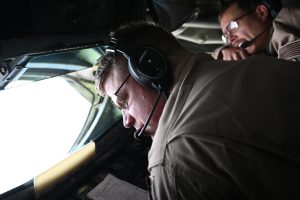
U.S. Air Force Tech. Sgt. Steven Hannah, a U.S. Air Force KC-135 Stratotanker boom operator, conducts preflight checks before takeoff during Exercise Ballast Cannon 24.3 at an undisclosed location within the U.S. Central Command area of responsibility, Jan. 7, 2024. Ballast Cannon is a routine bilateral exercise occurring nearly quarterly with the Royal Bahraini Air Force, which focuses on strengthening the bonds between coalition forces and building a foundation for future engagements in support of the combined defense of the Arabian Peninsula. (U.S. Air Force photo by Staff Sgt. Jasmonet Holmes)
An Air Forces Central release emphasized that this latest exercise is a “routine” event, with new editions of Ballast Cannon occurring roughly every three months. Previous iterations have not been publicized, but the USAF and RBAF have worked together before, participating in regional coalition operations, contributing to missions over Yemen and Iraq against Islamic State group fighters. In 2022, the two organizations also conducted a subject matter expert exchange focused on the C-130J aircraft.
“Through decades of collaboration and cooperation with our wonderful partners in the region, we have developed key relationships, bolstering our ability to integrate and employ airpower across the coalition,” Quadri said.
Agile Combat Employment is the Air Force’s operational concept whereby teams of Airmen and aircraft disperse from large central bases to various remote or austere locations, where they can operate with fewer resources and move quickly as needed.
Bahrain has operated F-16s of its own since the early 1990s. In 2018, the Gulf nation ordered 16 of Lockheed Martin’s newest Block 70 F-16s in a $1.1 billion contract. After completing flight tests at Edwards Air Force Base, Calif., the initial batch of these jets are set to be delivered to the RBAF this year.
